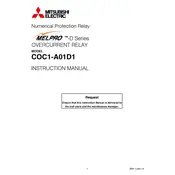Mitsubishi COC1-A01D1 Instruction Manual


The primary function of the Mitsubishi COC1-A01D1 Relay is to control electrical circuits by opening and closing contacts in another circuit. It is used for various applications requiring the management of electrical loads.
To install the Mitsubishi COC1-A01D1 Relay, mount it securely in the control panel using a DIN rail or panel mounting hardware. Ensure all connections are tight and follow the wiring diagram provided in the manual to avoid incorrect wiring.
If the relay doesn’t activate, check the power supply to ensure it is within specifications, inspect the wiring connections for any loose or damaged wires, and verify that the control signal is being sent to the relay.
To test the relay, apply the appropriate control voltage to the coil and listen for a clicking sound, indicating that the relay is operating. Use a multimeter to verify continuity between the contacts when the relay is activated.
Regularly inspect the relay for signs of wear or damage, clean contacts if necessary, and ensure that all connections are secure. Replace the relay if you notice any performance degradation or physical damage.
The Mitsubishi COC1-A01D1 Relay is designed to operate within a specified temperature range. Consult the product specifications to determine the maximum allowable ambient temperature and ensure the relay is not exposed to temperatures exceeding this limit.
Handle the relay by its body rather than the terminals to prevent damage. Avoid dropping or subjecting it to physical shock, and store it in a dry, dust-free environment until installation.
Indications of a failing relay include a failure to switch circuits, intermittent operation, unusual noises, or visible damage such as burnt contacts or a scorched coil.
Yes, the Mitsubishi COC1-A01D1 Relay can be used in both AC and DC circuits. However, ensure that the relay’s coil voltage and contact ratings are compatible with the circuit type and voltage levels being used.
Ensure the power is turned off before installation or maintenance, use insulated tools, and avoid contact with live circuits. Always follow the manufacturer's safety guidelines and local electrical codes.